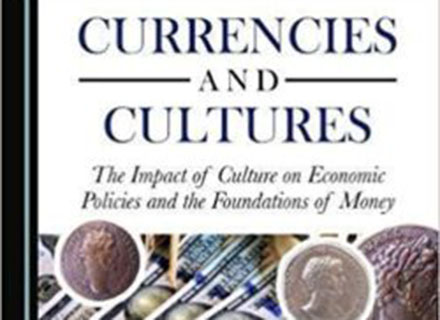Currency has spurred economic and social development, fostered trade, built civilizations, equipped armies and even helped create the Industrial Revolution.

But how much is known about the origins of currency, itself, and its evolution? Noel Mark Noël, PhD, an adjunct professor at USF St. Petersburg and a business professor at USF Sarasota-Manatee, explores these questions and investigates currency’s impact across the spectrum of social development in his new book Currencies and Cultures: The Impact of Culture on Economic Policies and the Foundations of Money.
One reason Alexander the Great was such a triumphant conqueror, Noël points out, was because he paid salaries – gold and silver coinage – to his troops. His soldiers used the coins to buy support from local peasants, winning their favor through “trickle-down economics.”
“He appreciated the strategic impact of currency,” said Noël, a hobbyist in the study of coins and other forms of money. His book explores the progression of money and how the world’s economies evolved from barter-and-trade and primitive currencies such as “salt money” and Chinese “knife money.”
In the purest sense, currency emerged because it was practical and could be easily moved and stored, Noël said. Precious metals – gold and silver – came into use to give value to coinage, which, in turn, led to standards of weights and measures. He credits the ancient Greeks as pioneers in this system in order to gauge coins’ intrinsic value and equate currencies from one region of the empire to those of another.
With currency’s development, banking and systems of finance evolved as well, setting the standard for centuries to come. However, one problem – counterfeiting – persisted through the centuries to threaten the economic growth. This was especially prevalent in early-18th Century England where it was believed that one in 10 coins was a forgery.
Seeking a solution, newly appointed Master of the Royal Mint Sir Isaac Newton sought to improve the credibility of coinage by setting the weight of gold to a specific value. This helped to transition England to the gold exchange standard and led to the development of paper currency backed by gold.

“Newton’s efforts were noteworthy because not only did they address counterfeiting, which was devastating to England’s economy, but they also led to the creation of a currency that was lighter and easier to transport and store than coinage,” Noel said. “The gold exchange standard would become the economic model for England and other nations to follow for hundreds of years.”
Noël’s book is intended for academic audiences but will appeal to anyone with an interest in currency, history and culture. According to the professor, if you want to understand a people and their history, “follow the money.”
Even currency, itself, can offer insights into a culture. Consider one of the most recognizable of American symbols, the dollar sign. A little-known fact is that the symbol is actually a Spanish invention that arose out of America’s early history with Spain.
It was taken from a 16th Century Spanish dollar. At the time, Spain had established military outposts across Mexico, the Caribbean and “La Florida” in St. Augustine to protect Central and South American gold and silver shipments destined for Spain.
Because of its prevalence in the 17th and 18th centuries, the Spanish dollar, or “pieces of eight,” became the most frequently distributed currency in the Colonies, and its unusual design and reliable silver content made it the most trusted coin adopted by colonists for common use.
“A symbiotic relationship exists between a currency and its culture and society,” Noël said. “The extent to which cultural institutions encourage and reinforce their economic foundations indicates the degree of a culture’s success or failure.”
Noël’s book also explores currency’s recent history, including in 1971 when America abandoned the gold standard in favor of government-backed currency. The final chapter explores the future of the dollar and its economic impact on our everyday lives.
Currency and Culture is available at Amazon.com and https://noelmarknoel.com/. The 255-page book came out in March.
